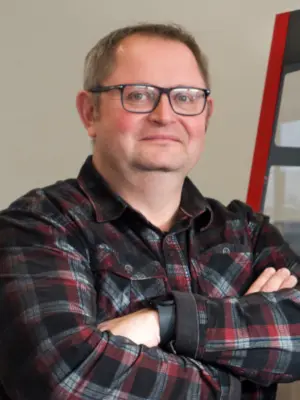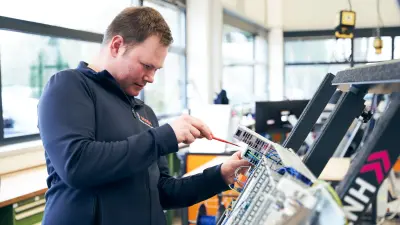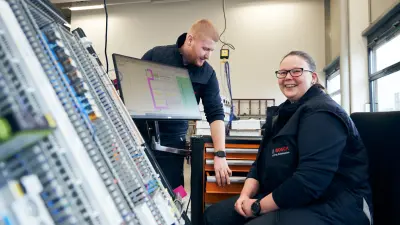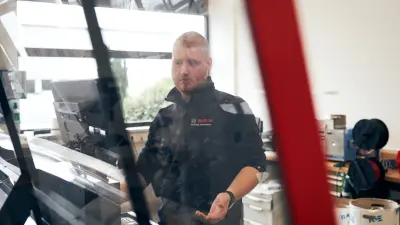Core components that bring buildings to life
Control cabinets make sure that buildings operate as intended. They are the invisible technical hearts of all building automation solutions. And because no two buildings are alike, Bosch Energy and Building Solutions only makes one-of-a-kind, custom-tailored control cabinets in its own facilities. A visit to Verl, a town in the German state of North Rhine-Westphalia, illuminates the advanced techniques used to craft them and the role played by digital twins.

Production supervisor Dirk Späte looks relaxed as he strolls through the production hall. Just a few years ago, while making his rounds he was still often called on to answer questions, assign tasks, and check work in progress. Today it’s enough for him to briefly glance inside the machine shop where three employees are busy milling and cutting metal sheets to very precisely prepare a housing for an upcoming project. Then Späte briefly detours into the component assembly area, where relays and connectors are being put together. A nod, a greeting – everyone already knows exactly what needs to be done. From there he proceeds to the component production area. “We now have a CAD-controlled machine for assembling cables,” explains Späte. “We can use it to prepare up to 90% of the cable sets for control cabinets.” The preassembled cable harnesses and other required components are laid out ready for use.

Here we create unique, top-quality models
Now we’ve arrived in the wiring shop. Panels prepared in the machine shop rest on worktables. A press of a button is all it takes to raise or lower them and adjust the angle just right so the workers can assume an ergonomic posture for wiring the electrical components and cable conduits.
“How control cabinets are built has changed quite a bit since I first started working here 25 years ago,” says Späte while looking approvingly over a female employee’s shoulder. “But the skilled manual work involved is still just as important as it’s always been.” A door further along, a finished control cabinet gleams. But before it’s dispatched to where it will be installed, a quality assurance team uses specially developed simulation software to put it through its paces and check every single detail. “This lets us make sure that all of the devices are correctly connected and the cabinet works flawlessly,” explains Späte at the end of the tour.
Bosch supplies control cabinets and building automation components from a single source

“Here we create unique, top-quality models,” says Späte. “This is important because control cabinets are what brings our high-quality building automation solutions to life.” They contain and control a collection of sensors, actuators, instruments, machines and other systems. A control cabinet is therefore the hub – or, as Dirk Späte calls it, the heart – of every automation solution. Bosch produces around 3 000 customized cabinets a year in Verl and in Waltenhofen in Bavaria. It takes an average of about a week to complete each panel. By producing its own tailored control cabinets, the company is able to ensure top quality while meeting customers’ wishes more transparently, flexibly, and rapidly.
Digital twins for an optimized production process
“In Verl we leverage the advantages of digitalization wherever possible, and are still adding to them,” says Späte. “It’s safe to say that Bosch is playing a pioneering role here. But this doesn’t mean that our human employees will become superfluous, even if we digitalize processes to an even greater extent. Manual work will still be required, but the tasks performed are going to shift. This also makes sense in view of the accelerating shortage of qualified workers.”
Späte is pleased with the progress and improvements in the processes that he has observed since digital tools were first introduced; and both quality and speed are poised to continue increasing. For two years now, control cabinets have been produced on the basis of a virtual image that is used to configure all of the work steps involved. First a digital twin of the control cabinet is generated on the basis of the project plans, including all required components and wiring. After successful digital testing, actual physical production gets underway. Here too, depending on the work step, it’s possible to all up a 3D virtual view of either the entire cabinet or only the part that is relevant to that particular step.
“After the new system was introduced, our employees were convinced of its benefits at the latest when they started using the 24-inch screen of a tablet computer to zoom in on the plan when necessary,” recalls Späte. Thanks to the digital twin, today the individual steps involved in production are easier to perform and each employee’s work can be easily done by someone else. “Control cabinets are built by hand. Everyone has their own style. But thanks to the digital twin, now it’s easy to visualize and understand each and every step,” explains Späte.

Every building is different, and every control cabinet is also unique
To ensure that a building automation solution unfolds its full potential, control cabinets are individually designed. “Buildings vary in size, and a different number of data points is processed on each floor,” says Späte. “That’s why we treat every project and cabinet as a one-off and plan it afresh from the word go, although we naturally reuse certain mechanisms and prefabricated layouts. At the end of the day, however, every time we have to rethink how to optimally accommodate all of the relays, circuits, and different currents in the housing. It’s also necessary to consider how much space the customer has available for installing the cabinet.” The digital twin makes it possible to view the entire project while carrying out each step. In the metalworking shop, where the housings are machined and mounting plates prefabricated, the fitter opens the assembly plan in a 2D or 3D view and zooms in on the individual components to make sure that they don’t have a cutting edge inside a cable canal or top-hat rail. The other specialists also take advantage of these capabilities. “Not everything can be digitalized,” adds Späte. “If I’m working with a certain current, I have to appropriately prepare the busbars. This is a job for a skilled specialist.” Other steps involved in wiring are simplified by step-by-step instructions or color coding. Next, an overhead projector points a beam of light onto the mounting plate to indicate where each component in turn needs to be clicked into place. “It’s kind of like painting by numbers,” says Späte with a grin.

The demand for distributed solutions is growing
The field of control panel production is continuing to evolve and increase in complexity. And the demand for distributed solutions is also rising. The trend in building automation projects is for each unit to comprise several smaller digital control cabinets. This saves customers money, because significantly fewer wires and cables are needed. “The challenge is accommodating all of the assemblies in a cabinet of a particular size,” explains the control cabinet expert. Another advantage of solutions from a single source is that the team involved can flexibly respond to requests for changes at any time right up until a finished cabinet is dispatched. And later, when a system is being used, the documentation created with the digital twin saves the customer money. A click is all it takes to pinpoint the relevant work step.
Especially in preexisting buildings, the experience and expertise that Bosch has gained from producing its own control cabinets are playing an increasingly important role. When modifying an existing installation, typically not all of the systems are completely replaced. “Our experience and creativity come into play here. It's a challenge to modify existing systems while they’re running. Our job is to develop these special solutions so that they’re as easy as possible for the team to implement on site,” explains Späte. Detailed preparations are a must for migrating from old to new cabinets.
More visibility
Asked whether he has any special wishes, Späte replies that if it were possible he would love to install control cabinets and building automation components more prominently: “Customers always want control cabinets to be inconspicuous. But these automation systems are the heart and soul of every building. They deserve to be displayed!”




